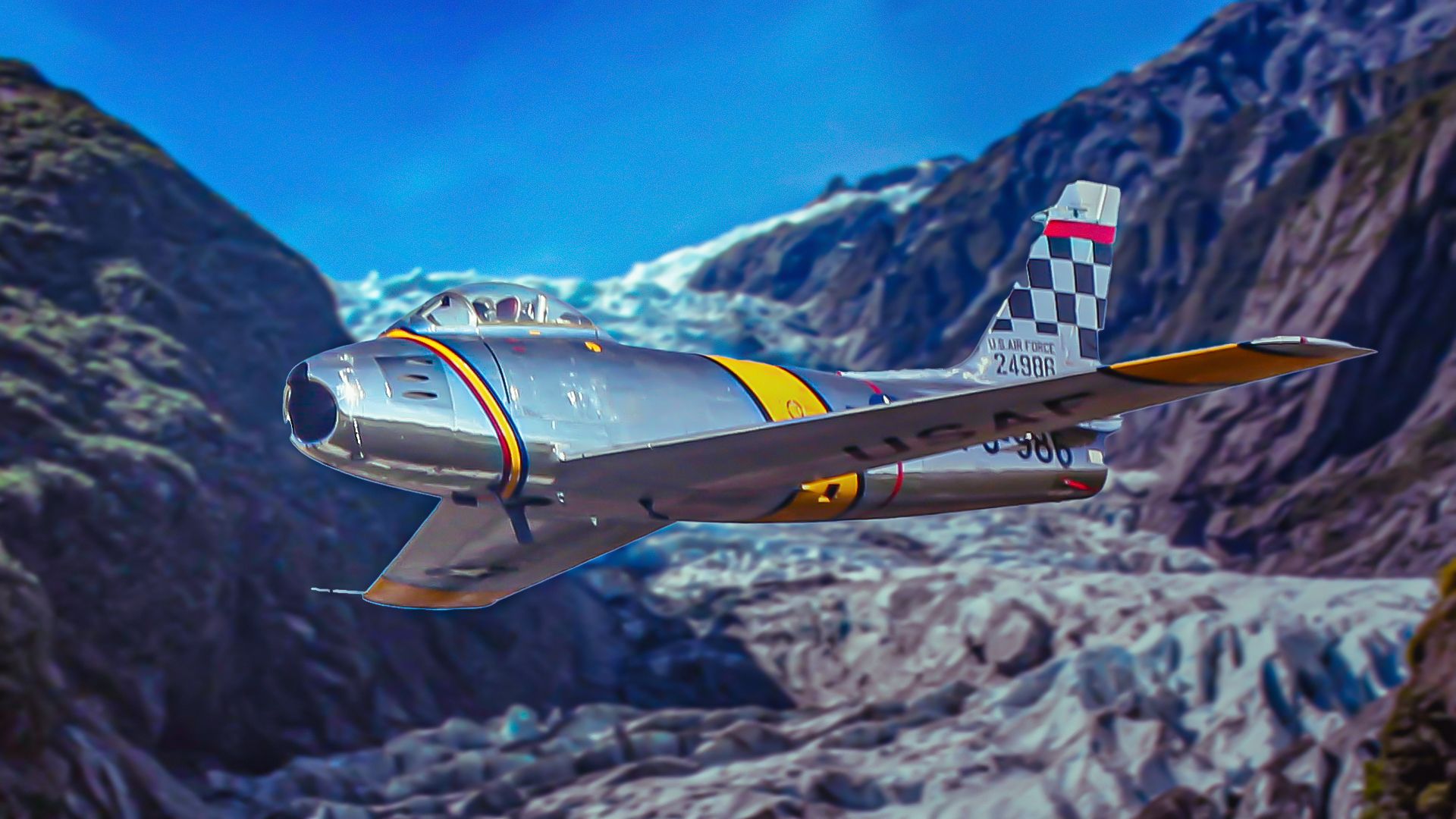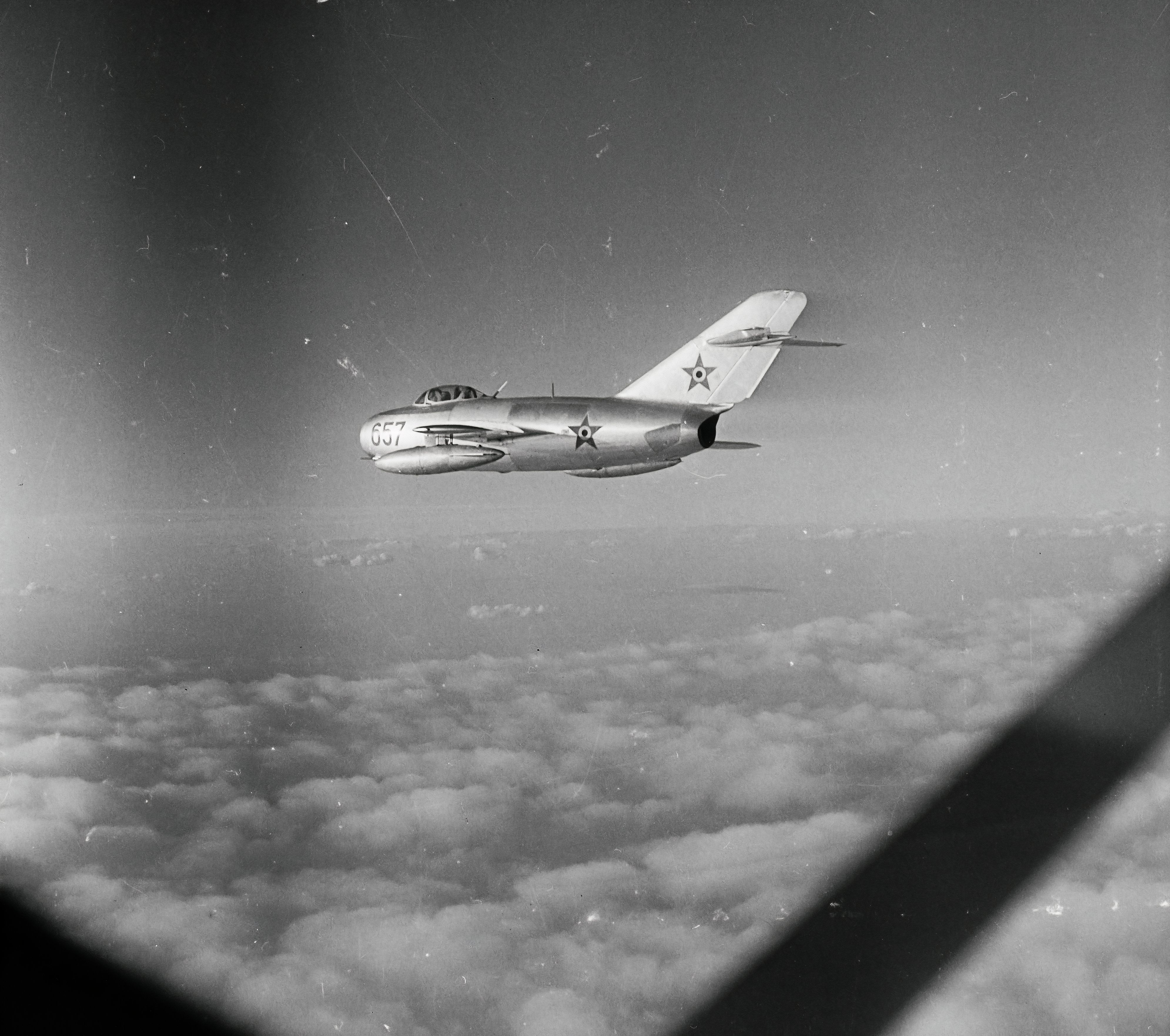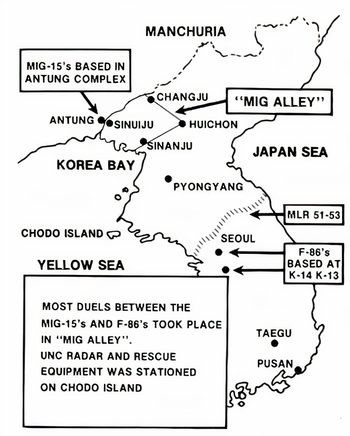The venerable F-86 Sabre was the first swept fighter to take to the skies for the
US Air Force.
The Sabre was built by North American and became the iconic image of the air war in Korea.
“The fight for air superiority began the day the Korean War started and only ended with the armistice three years later. Once the shock of the North Koreans’ invasion wore off, it did not take long for the United States Air Force, assisted by other United Nations air forces, to destroy the North Korean Air Force.” – from ‘MiG Alley: The fight for Air Superiority’ by William T. Y’Blood
The arrival of the MiG–15 in November 1950, often flown by Soviet pilots, changed things considerably however. For the remainder of the Korean war – bitterly contested air battles were fought on an almost daily basis. Despite a decided numerical superiority in jet fighter aircraft, the Communist air forces of North Korea. China and the Soviet Union were never able to gain air superiority.
A feat that testified to the skill and training of the UN fighter pilots. The veteran fighter pilots of the U.S. Air Force were highly skilled and well-trained. Combining the potent skills of these seasoned airmen with the rapidly advancing technology that the F-86 was continuously updated with allowed the allied coalition to stave off the persistent waves of Communist air attacks.
The dawn of the Jet Age came at the same moment in history as the heyday of Cold War espionage
F-86 Specifications
- Armament: Six .50-cal. machine guns
- Engine: General Electric J47 of 5,200 lbs. thrust
- Maximum speed: 685 mph
- Range: 1,200 miles
- Ceiling: 49,000 ft.
- Span: 37 ft. 1 in.
- Length: 37 ft. 6 in.
- Height: 14 ft. 8 in.
- Weight: 13,791 lbs. loaded
MiG-15 Specifications
- Armament: Two 23mm cannons and one 37mm cannon plus rockets or 2,000 lbs. of bombs
- Engine: Klimov VK-1 of 6,000 lbs. thrust (developed from the British Rolls-Royce “Nene” engine)
- Maximum speed: 670 mph
- Range: 500 miles
- Ceiling: 51,000 ft.
- Span: 33 ft. 1 1/2 in.
- Length: 33 ft. 3 5/8 in.
- Height: 11 ft. 2 in.
- Weight: 11,270 lbs. maximum
MiG Alley
The first captured Sabre was an F-86A variant that was forced into a water landing due to damage from dogfighting with Soviet piloted MiG-15s. The pilot was rescued by the US Navy but after a 3 hour aerial battle resulting in the loss of seven MiG-15s, the joint Chinese-Soviet salvage effort was able to retrieve the Sabre to be examined in Moscow.
The second captured Sabre was a later F-86E variant, also forced to crash land due to battle damage. This time over land in North Korea. The pilot was injured but survived, becoming a POW. He was eventually repatriated after the armistice.
The MiG-17 was nearing production when the first Sabre was reverse engineered. The only major gain to result for the Soviets was invention of a radar detection-warning receiver that alerted pilots when they were being targeted by the Sabre’s gunsight. This modification was made in the field to Mig-15s deployed in North Korea and after proving it’s capability, all later models of Soviet fighters incorporated versions of this system. The key reverse engineering take-aways for the Soviets were the radar aimed, automated gunsight, the all-moving horizontal stabilizer and most importantly the G-suit system.
The F-86E that was captured later in the conflict featured a horizontal stabilizer that an all-moving surface. Soviet engineers modified an experimental MiG-17 with a similar design and test pilots experimented with the handling characteristics to find that it was capable of drastically increasing the maneuverability of the aircraft. This performance was impressive enough that the MiG-19 and later generations incorporated the all-moving horizontal stabilizer design.
The greatest improvement to result from the captured Sabres was copying the G-suit system. The increased performance of pilots under G-load was a far greater increase in lethality for the future generations of MiGs than any aerodynamic or weapons systems improvements.
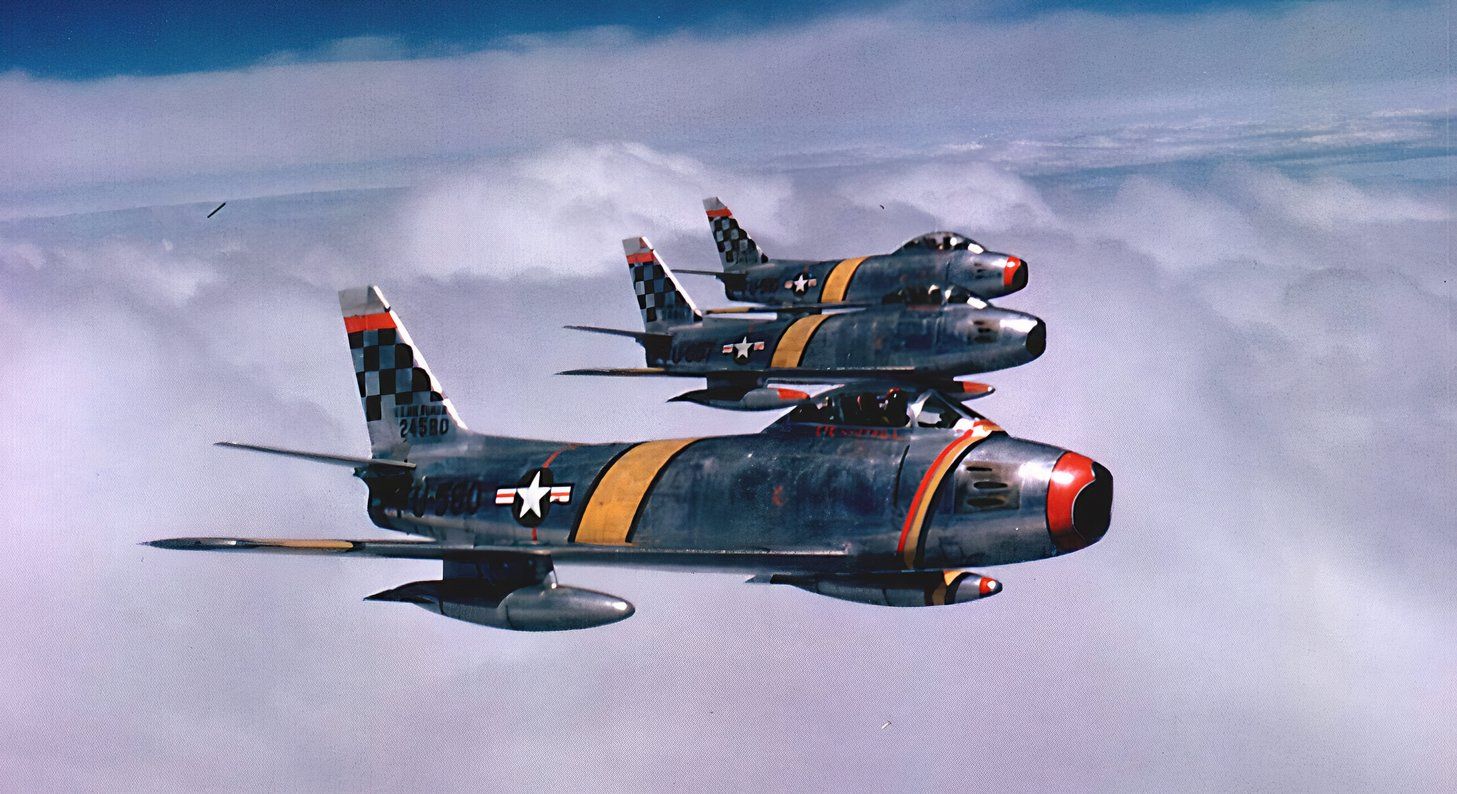
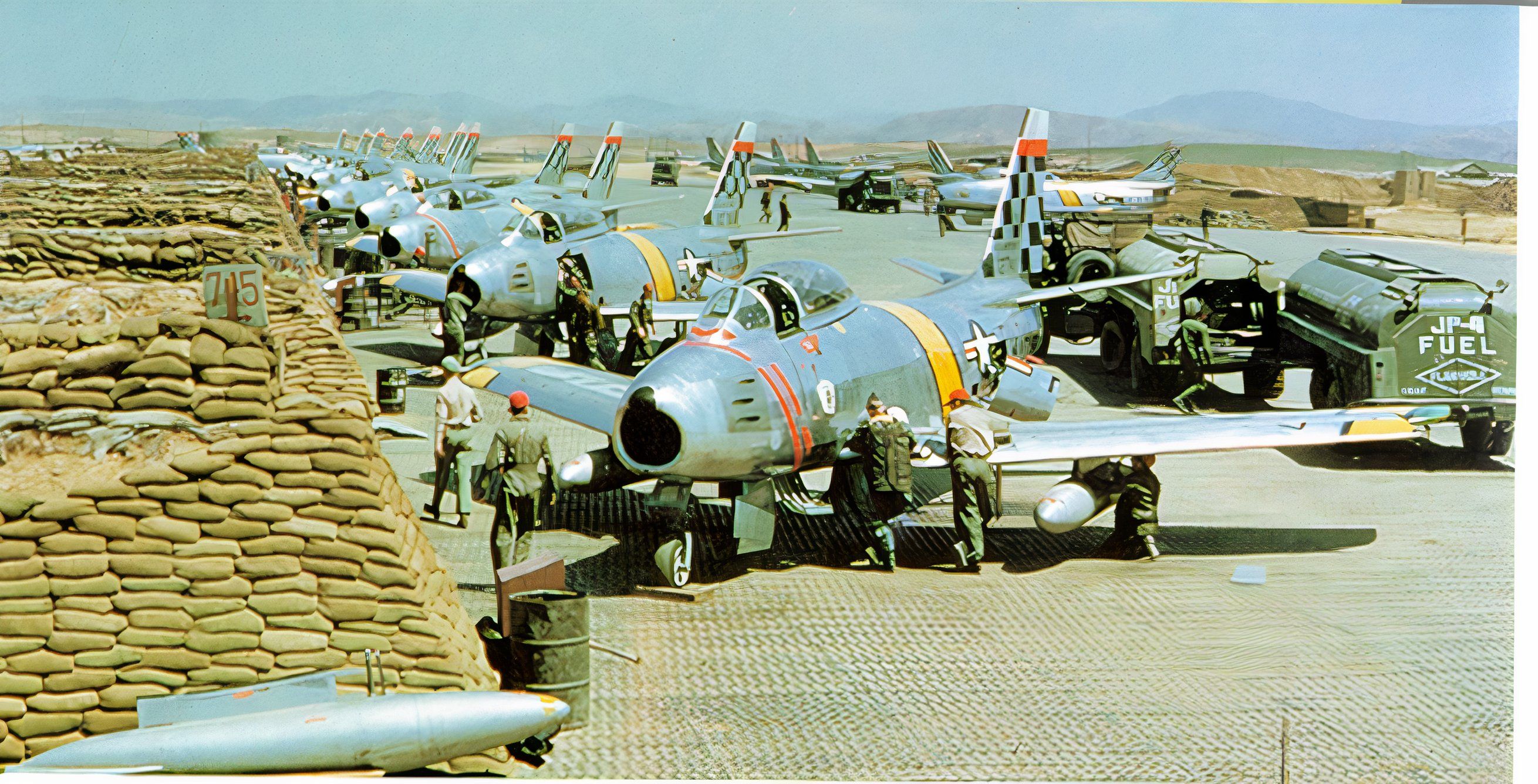
Cold War Rubicon: The Yalu River
The chaotic nature of the conflict in Korea, combined with the fog of war that clouded so much of the truth during the Cold War Era means that it may never be clear exactly how the aerial contest of the F-86 and MiG-15 was settled in the skies over Korea.
Various sources in the post-war have claimed that late in the war the U.S. airmen probably scored many more victories than the official records show. Since the armistice between North and South Korea were have been many attempts to improve the historical records of many events from the war. These victories were usually made across the Yalu in Manchuria. Despite the prohibitions on crossing the river, in the heat of battle accidental incursions did occur.
Some sources state, however, that many missions were deliberately flown across the Yalu to catch MiGs at their most vulnerable time, in the traffic patterns or on the ground at the Communist airfields.
Parked fighters could also be seen on these films. Among pilots claimed to have strayed across the river were Gabreski, Lt. Col. George Jones (a 6&1/2 ace), Maj. William T. Whisner, Jr. (5&1/2 MiGs), and Col. Walker M. “Bud” Mahurin, the famed World War II ace who shot down 3&1/2 MiG–15s.
While there may remain many remnants of the Korean War, as the armistice remains in effect and the peninsula divided, the valiant fighter pilots of both sides pushed the advance of the jet age forward through dramatic aerial battles at speeds never seen before. Today’s fifth generation fighters bear the fruit of the seeds sowed by the brave souls that took the air in defense of freedom in MiG Alley.

